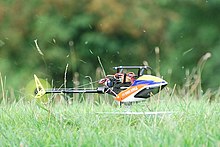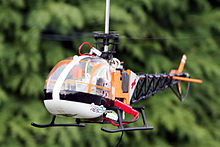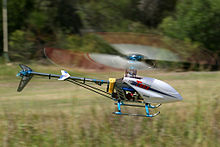Radio-controlled helicopter
This article includes a list of general references, but it lacks sufficient corresponding inline citations. (August 2010) |






Radio-controlled helicopters (also RC helicopters) are model aircraft which are distinct from RC airplanes because of the differences in construction, aerodynamics, and flight training. Several basic designs of RC helicopters exist, of which some (such as those with collective pitch, meaning blades which rotate on their longitudinal axis to vary or reverse lift so the pitch can be altered and can therefore change the angle of attack) are more maneuverable than others. The more maneuverable designs are often harder to fly, but benefit from greater aerobatic capabilities.
Flight controls allow pilots to control the collective and throttle (usually linked together), the cyclic controls (pitch and roll), and the tail rotor (yaw). Controlling these in unison enables the helicopter to perform most [citation needed] of the same maneuvres as full-sized helicopters, such as hovering and backwards flight, and many that full-sized helicopters cannot, such as inverted flight (where collective pitch control provides negative blade pitch to hold heli up inverted, and pitch/yaw controls must be reversed by pilot).
The various helicopter controls are effected by means of small servo motors, commonly known as servos. A piezoelectric gyroscope is typically used on the tail rotor (yaw) control to counter wind- and torque-reaction-induced tail movement. This "gyro" does not itself apply a mechanical force, but electronically adjusts the control signal to the tail rotor servo.
The engines typically used to be methanol-powered two-stroke motors, but electric brushless motors combined with a high-performance lithium polymer battery (or lipo) are now more common and provide improved efficiency, performance and lifespan compared to brushed motors, while decreasing prices bring them within reach of hobbyists. Gasoline and jet turbine engines are also used.[1]
Types of R/C helicopters
Common power sources of R/C helicopters are glow fuel (also called nitro fuel - nitromethane-methanol), electric batteries, gasoline (petrol) and turbine engines. For the first 40 years, glow fuel helicopters were the most common type produced. However, in the last 10 years, Electric powered helicopters have matured to a point where power and flight times have equaled glow fuel helicopters.
There have been two main types of systems to control the main rotors, mechanical mixing and cyclic/collective pitch mixing (CCPM). Most earlier helicopters used mechanical mixing. Today, nearly all R/C helicopter use CCPM.
Practical electric helicopters are a recent development but have rapidly developed and become more common, overtaking Glow fuel helicopters in common use. Turbine helicopters are also increasing in popularity, although the high cost puts them out of reach of most people.
Glow fuel (nitro fuel)
Glow fuel, or nitro fuel helicopters (not to be confused with gas, or gasoline powered helicopters) have been made in several sizes over the years. These are referred to as the "class" of the helicopter. They include 1/2A class, 15 class, 30 class, 50 class, 60 class and 90 class. These class numbers originated from the size of engine (engine displacement measured in cubic inches) used in the different models. For example, a helicopter with a .30 cubic inch engine is a "30 class" and a helicopter with a .90 cubic inch engine was referred to as a "90 class" helicopter. The bigger and more powerful the engine, the larger the main rotor blade that it can turn and hence the bigger the aircraft overall. Typical flight time for nitro helicopters is 7–15 minutes depending on the engine size and tuning. The maximum height of operation for RC helicopters, be it glow fuel, gasoline, turbine or electric, is effectively limited to the height at which the model is still visible. Most quality radio control systems have a range of over a mile, when the model would be long out of sight.
Electric

Two small electric helicopters emerged in the mid-1990s. These were the Kalt Whisper and the Kyosho EP Concept, flying on 7/8 1200 mah NiCad batteries with brushed motors. However, the `540' brushed sized motors were on the limit of current draw, often 20-25 amps on the `hotter' motors, hence brush and commutator problems were common.
Recent advancements in battery technology are making electric flying more feasible in terms of flying time. Lithium polymer (LiPo) batteries are able to provide the high current required for high performance aerobatics while still remaining very light. Typical flight times are 4–12 minutes depending on the flying style and battery capacity.
In the past electric helicopters were used mainly indoors due to the small size and lack of fumes. Larger electric helicopters suitable for outdoor flight and advanced aerobatics have become a reality over the last few years and have become very popular. Their quietness has made them very popular for flying sites close to residential areas and in places such as Germany where there are strict noise restrictions. Nitro helicopters have also been converted to electric power by commercial and home made kits.
The smallest remote-controlled production model helicopter made (Guinness World Records 2006) is the Picooz Extreme MX-1 sold at many toy stores (although this is infrared controlled, not radio), electronics stores and internet stores, costing about $30 (£28). The next smallest is the standard Picooz helicopter.
Several models are in contention for the title of the smallest non-production remote-controlled helicopter, including the Pixelito family of micro helicopters, the Proxflyer family, and the Micro flying robot.
A recent innovation is that of coaxial electric helicopters. The system's simple direction control and freedom from torque induced yaw have, in recent years, made it a good candidate on small models for beginner and/or indoor use. Models of this type, as in the case of a full-scale helicopter, eliminate rotational torque and can have extremely quick control response, both of which are very pronounced in a CCPM model.
While a coaxial model is very stable and can be flown indoors even in tight quarters, such a helicopter has limited forward speed, especially outdoors. Most models are fixed-pitch, i.e. the collective pitch of the blades cannot be controlled, plus the cyclic control is only applied to the lower rotor. Compensating for even the slightest breeze causes the model to climb rather than to fly forward even with full application of cyclic. More advanced coaxial constructions with two swash plates and/or pitch control - common for the big coaxial helicopters like Kamovs - have been realized as models in individual projects but have not seen the mass market as of 2009.
Radio gear
Radio
Small fixed-pitch helicopters need a 4-channel radio (throttle, elevator, aileron, rudder), although micro helicopters that utilize a 2-channel infrared control system also exist; while collective-pitch models need a minimum of 5 channels with 6 being most common (throttle, collective pitch, elevator, aileron, rudder and gyro gain). Because of the normal interaction of the various control mechanisms, advanced radios include adjustable mixing functions, such as throttle/collective and throttle/rudder.
Radio prices vary from $50–$3,000 USD.
Well-known manufacturers of helicopter-specific radio controllers include: JR, Spektrum, Futaba, Hitec, Sanwa (known as "Airtronics" in North America), Multiplex (a division of Hitec), and OrangeRX. The original preferred user interface for helicopter-oriented RC transmitters at the beginning of the RC helicopter hobby, from the early 1970s through about 1990, was the so-called "single-stick" or "knobby" style of multi-channel RC transmitter, possessing a single primary two-axis joystick with a special rotatable, self-centering knob atop the single joystick's shaft for all three of the helicopter's aerodynamic controls, combined into only one primary control mechanism. The horizontal/vertical joystick movements of such a joystick provide cyclic control, and the knob is used for operating the tail rotor control. Such radios became unavailable as factory-built new units at the start of the 1990s, but newer units are still made by RC-flying electronics hobbyists well into the 21st century in North America for their own personal use, for flying both RC helicopters and fixed-wing RC model aircraft.
Modulation
Early Radio Controls Systems used AM (Amplitude Modulation) to transmit their signals. In the late 70's, FM (Frequency Modulation) became more commonplace.
PCM
Pulse Code Modulation. A scheme in which the commanded position for each servo is transmitted as a digitally encoded number. Manufacturers use their own proprietary system to encode this number with various levels of precision (i.e. variable number of bits per servo position). JR use Z-PCM (9 bits, 512 different values: 0...511) then S-PCM (10 bits, 1024 values: 0...1023). Futaba use PCM-1024 and G3 PCM (11 bits, 2048 values: 0...2047). With PCM not all positions are broadcast at one time (each frame) to save time. The odd numbered positions are sent as absolute in one frame, with the even sent only as differences from their previous values. The next frame the opposite is done. PCM includes a checksum at the end of the frame to check the signal's validity. Hence, if there is interference and the signal arrives distorted at the Receiver, utilizing the checksum it is able to know if it is the original. In case it is not, a feature called Fail-Safe is implemented to set servo positions to a predefined position, or to hold them at the last valid position.
PPM
Pulse-position modulation. A scheme in which the commanded position for each servo is transmitted as the duty-cycle of the transmitted pulses 1 per servo position. PPM is cheaper than PCM and is generally used in low-end helicopters. The lack of a failsafe in PPM makes it more suited to small, less dangerous models. Higher-end radios offer PCM and PPM modulation for better compatibility with all radio receivers.[2]
Spread spectrum

Systems such as FHSS (frequency-hopping spread spectrum) used by Futaba employ frequency hopping on the 2.4 GHz band instead of the various frequencies in the lower MHz ranges. The advantage is that radios are no longer using a fixed frequency during flight, mitigating the risk of interference on that fixed frequency.
Systems such as Spektrum and JR use the DSM2 DSSS(Direct-sequence spread spectrum) method, where they transmit on a pair of fixed channels chosen when the radio and receiver are turned on. Any subsequent systems would avoid using these channels and continue searching for another unused pair of channels.
With either method many radios can be transmitting at once without interfering with each other. The Futaba systems change frequency approximately every two milliseconds, so even if two transmitters are using the same channel they are not doing so for long. The pilot will not notice any abnormal behavior of the model in the 1/500th of a second that they are interfering. This gives one the advantage of turning on a transmitter without regard to channels currently in use by other pilots' radios.
One downside to 2.4 GHz is that precautions must be taken during installation since certain materials such as carbon fiber can mask the signal. In some cases, "satellite" receivers with secondary antennas need to be used to maintain better line-of-sight with the transmitter radio. Another drawback is that a 2.4 GHz standard has yet to evolve so that receivers and transmitters can be mixed regardless of their respective manufacturer.
Controls
RC Helicopters usually have at least four controls: Roll - Cyclic Pitch, Elevator (Fore-Aft Cyclic Pitch), Rudder (Yaw) and Pitch/Throttle (Collective Pitch/Power).
For simple flight, the radio is usually configured such that pitch is around -1 degree at 0% throttle stick, and somewhere around 10 degrees at 100% throttle stick. It is also necessary to modulate the throttle in conjunction with the pitch so that the model maintains a constant 'head speed' (the rotor's RPM). This is beneficial for consistent and smooth flight performance.
If aerobatic '3D' performance is desired, then the 'idle up' mode of flight is used. In this mode, the collective pitch ranges from its negative limit at 0% throttle stick input, up to its positive limit at 100% throttle stick. The throttle, on the other hand, is modulated automatically by the radio transmitter to maintain a constant head speed and is usually at its lowest value when the throttle stick is centered and the pitch is zero. This mode allows the rotor to produce a thrust 'upwards' (by using negative pitch) which, when the model is inverted, allows sustained inverted flight. Usually a more advanced computer radio is used for this kind of flying, which allows customization of the throttle-collective mix.
The cyclic and yaw controls are not by definition different in these two modes, though 3D pilots may configure their models to be much more responsive.
Construction

Construction is typically of plastic, glass-reinforced plastic, aluminium or carbon fiber. Rotor blades are typically made of wood, fiberglass or carbon fiber. Models are typically purchased in kit form from one of about a dozen popular manufacturers and take 5 to 20 hours to completely assemble.
These model helicopters contain many moving parts analogous to those on full-size helicopters, from the swashplate to rotor and everything in between.
The construction of helicopters has to be more precise than for fixed-wing model aircraft, because helicopters are susceptible to even the smallest of vibrations, which can cause problems when the helicopter is in flight.
Additionally, the small size and low weight of R/C helicopters and their components means that control inputs, especially cyclic (pitch and roll) can have a very fast response, and cause a rotation rate much faster than the equivalent input might produce on a full-size aircraft. In some cases, this quick response can make the model unnecessarily difficult to fly. For this reason, most model helicopters do not use the (simpler) Bell rotor head design, but instead use the Hiller design with a flybar, or Bell-Hiller mixing, the former providing a much greater degree of stability, and the latter mixing the quick response of the Bell system with the stability of the Hiller design. Some models use the simple Bell design, but this is limited mainly to scale models that are more challenging to fly, or models using advanced electronic stabilizing equipment.
To reduce mechanical complexity and increase precision of the control of the swashplate some model helicopters use Cyclic/collective pitch mixing.
Competition
Aerobatic helicopter flying has historically followed the Fédération Aéronautique Internationale rules, which for helicopters are labelled F3C. These include a predetermined routine of hovering and aerobatics.
An advanced form of RC helicopter flying is called 3D. During 3D flying, helicopters perform advanced aerobatics, sometimes in a freestyle form, or in a predetermined set of moves drawn up by the organisers of the competition. There are a number of 3D competitions around the world, two of the best known being the 3D Masters in the UK and the eXtreme Flight Championship (XFC) in the USA.
Commercial applications
Although RC helicopters are generally used by hobbyists for recreational purposes, they are sometimes used in applications such as low altitude aerial photography, filming, policing, and remote observation or inspection. Some companies make RC helicopters specifically for these uses.
Recent (2006) FAA regulations grounding all commercial RC model flights have been upgraded to require formal FAA certification before permission to fly at any altitude in USA.
Miniature helicopters
Miniature helicopters are remotely controlled helicopters with a weight ranging from hundred grams to a few grams. Most in production are toys aimed at hobbyists and enthusiasts. In addition there are many companies making prototypes for military and security applications. Miniature helicopters are popular demonstrations for the latest technologies in miniaturization.[3]
Examples of these types of miniaturized models are the E-Flite Blade CX and CX2 and the Picoo Z, a popular consumer model. Also is the Proxflyer, a prototype and basis for many production models. One final example is a one-off prototype and technology demonstration item that was developed by Seiko Epson and demonstrated at the International Robot Exhibition in Tokyo is the Seiko Epson Micro flying robot.
- Miniaturization

Techniques involve reduction of weight and complexity compared to normal sized RC helicopters:
- Use of densest power sources available, such as lithium polymer.
- Battery capacity only enough for a short flight, typically a few minutes.
- Miniature DC motors.
- Electronics made of SMD components and ASIC chips.
- Light plastics or carbon fiber fixtures and structure.
- Infrared control instead of radio.
- Auto-stabilization with Stabilizer bar
- No servos; directional control only via variable power to the tail rotor.
References
- ^ "Buyers Guide". Intermediate/Advanced Outdoor Models. RCMods. Retrieved 29 May 2013.
- ^ "Radio protocols". RC Helicopter Wiki. Retrieved 29 May 2013.
- ^ Epson Corporate: Newsroom
